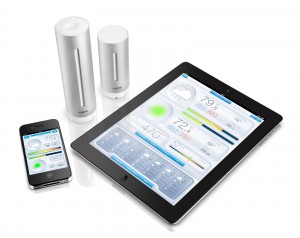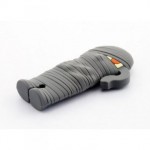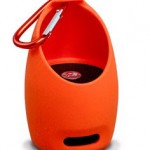If you’ve always fancied yourself the next Michael Fish, or if you’re at a loss for what to buy for Christmas, Netatmo has just the thing you’re looking for.
The Netatmo Urban Weather Station
The Netatmo Urban Weather Station is the world’s first personal weather station, letting you monitor environmental elements indoors and outside to help you plan your comings and goings. The device transmits data through WiFi to an app which is accessible on Apple and Android devices as well as through internet browsers.
What’s in the box???
The generic kit consists of two cylindrical units, one for indoor use and one for outdoor, with the option of purchasing additional units which can be linked up to the same app/network. The whole contraption is easy to set up and has you ready to go within a few minutes and the app (which I viewed on an android phone, Nexus 7 and iMac, using the web app) is commendably clean and easy to read.
It monitors: temperature, CO2 levels, humidity, noise levels and pressure
Retail price: £159 available at www.netatmo.com and elsewhere
What would you get out of it?
There’s no question about whether the Netatmo weather station is good at what it does – as far as I could tell it is pretty accurate at measuring and forecasting. But I do have to question what use the average human being would get out of it and I’m not entirely sure what the point of this thing is. It is definitely interesting to monitor the levels of various things in your surroundings, but it doesn’t really do anything that couldn’t be achieved by simply being in a given room and using your regular human senses.
And it doesn’t really offer any novel solutions for tackling the high levels of X (where ‘X’ is usually carbon dioxide) that it records. For example, if the CO2 levels rise above 1000 ppm/parts per million (which, if you’re in a regular sized room and breathing, is most of the time) you can open the window to lower them and make the room a more comfortable place within which to exist – however, you don’t really need to have an indicator to tell you this: you can tell the CO2 levels are high because that’s when the room begins to feel a bit stuffy. You don’t need to know the exact ppm figure because you can feel it. Unless you’re running a science experiment or are particularly interested in how the ‘atmosphere’ within a room changes over the course of the day, this is pretty unnecessary.
Keeping track of how stuffy it is back home
The station takes readings automatically every 5 minutes through averaging all stats over every 5 minute interval in order to avoid anomalies and you can access these readings at any time via the app, as some of the feedback quoted on the Netatmo site reflects. The following quote is from Mashable, 10 June 2013:
‘Dad can even monitor his home environment when he isn’t there.’
Now, this is a fair and accurate point but again I’m left wondering what the practical use of being able to do this is. If the gadget was able to detect potentially harmful gases then this would have more value, but as it stands all Dad would be keeping track of is how stuffy it is back home. I am surprised that the station doesn’t have a sensor for something like carbon monoxide as that would make it more marketable as a health-and-safety device – or perhaps methane, which would make it hilarious. At the moment it feels like it doesn’t quite do enough to legitimise it’s price and the lay public’s interest in it. Regardless of how useful (or not) the current readings are, they are, at least at times, interesting so adding more parameters would definitely help increase the appeal.
A lot of window wafting
The perk of the outdoor monitor is supposed to help you plan when to travel and generally go outside – which is fine for spontaneous weekend activities but utterly irrelevant for almost everything else given that with travelling you normally have to book things in advance and with work there are the normal 9-5 comings and goings to adhere to. As for planning activities days in advance based upon weather forecasts – the device also forecasts the weather for the coming week and, as far as I could tell over the space of a week or two, it is fairly accurate – you can find forecasts for free online using any device connected to the internet.
Overall, I did enjoy monitoring the ‘atmosphere’ inside my house (particularly the CO2 levels as these are easy to control via opening windows/panting/turning the heating on) for the first couple of days that I had the Netatmo weather station – but the novelty soon wore off.
At night in particular, the CO2 levels rise considerably if you have the window shut as all you’re doing is existing in a confined space and steadily breathing more CO2 into the air – and gods forbid you have the heating on as this immediately hurls the CO2 indicator into yellow alert. I found it a bit annoying after a while because I would check the readings, see that CO2 levels were yellow or amber (around 1000 ppm and above) and open the window to bring levels down again – this, when done on cue, will occur around about once an hour. That’s a lot of window wafting.
In short: unless this device is specifically something you have always wanted, you probably don’t need it.
Netatmo’s Urban Weather Station is now available for £159 at www.netatmo.com. The Netatmo app is available for free on the App Store.
There is also a Netatmo thermostat scheduled for UK release sometime in 2014 – for info and pics check out this article on the Stuff website http://www.stuff.tv/netatmos-philippe-starck-designed-thermostat-simply-beautiful/news





 It’s Alive! – Bone Mummy Headphone Wrap
It’s Alive! – Bone Mummy Headphone Wrap Hands on with Blue Microphone’s Mikey Digital for iProducts
Hands on with Blue Microphone’s Mikey Digital for iProducts Bongo Drop Bluetooth Speaker – Ideal for on the go
Bongo Drop Bluetooth Speaker – Ideal for on the go Patrona insanely expensive iPhone Wallet. I still want it though
Patrona insanely expensive iPhone Wallet. I still want it though RSS
RSS
[…] The Netatmo Urban Weather Station is the world’s first personal weather station, letting you monitor environmental elements indoors and outside to help you plan your comings and goings. The device transmits data through WiFi to an app which is accessible on Apple and Android devices as well as through internet browsers. READ MORE […]